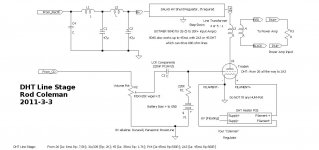In my preamp PSUs I use only direct heating rectifier tubes.after discovering how different rectifiers sound.
My prefered type is AZ1 mesh (I have some Telefunken AZ1 mesh tubes). Not cheap, but affordable (buy once, use for years).
IMHO the best of them is the globe type with large mesh plate.
I've found a very good article on hum in amplifiers, and best of all with references. Maybe something to learn. I hope. [PDF]An article on Hum in Valve Amplifiers
Actually, that's what I was using, but at the moment the Mullard AZ31 I have just put in sounds more alive. I will have to try swapping them around.In my preamp PSUs I use only direct heating rectifier tubes.
My prefered type is AZ1 mesh (I have some Telefunken AZ1 mesh tubes). Not cheap, but affordable (buy once, use for years).
IMHO the best of them is the globe type with large mesh plate.
Thanks for that. As a beginner here, I need to learn as much as I can. But I'll read it before I've had a drink.I've found a very good article on hum in amplifiers, and best of all with references. Maybe something to learn. I hope. [PDF]An article on Hum in Valve Amplifiers
 It is Friday night, after all!
It is Friday night, after all! Cunningham and RCA would have been made in the same plant by the time the 26 tube was released.
My Radiotron globe tubes plate structure is precise, the plate disc covers the grid and -mostly- the filament, the distance between plate and top mica is consistent.
The Cunninghams shaping is variable, some plate disc is "lower", some "higher", so top mica almost touching the plate.
The Radiotrons -in my measuring set- THD alters between 0.002 and 0.05, the Cunninghams 0.05-0.13. Most of them has higher distortion.
I've read a little bit more on this hum thing and it seems that hum (50 or 60 Hz) is generated by the mains wiring in houses and that it is transmitting electromagnetic fields in open air to everything that's willing and able to pick it up. And every body - including the human body - picks it up to a greater or lesser degree. If that's correct I'll assume that a big valve (or a big person) is a better receiver or antenna than a small valve.
Has anyone tried changing the polarity of the filament heaters to check if that's making a difference on hum levels?
Has anyone tried changing the polarity of the filament heaters to check if that's making a difference on hum levels?
I personally wouldn't worry too much, but it's your call. I swap old DHTs all the time. 26s are quite robust.
What I do is use my bench supply to test tubes for current at my chosen voltage. Gives some indication of the response. I test 4P1Ls at 2v, for instance, and mark the current on a label I attach to the base. Not as sophisticated as using a valve tester - I have two AVOs which need renovating and which I want to sell if anyone is interested.
What I do is use my bench supply to test tubes for current at my chosen voltage. Gives some indication of the response. I test 4P1Ls at 2v, for instance, and mark the current on a label I attach to the base. Not as sophisticated as using a valve tester - I have two AVOs which need renovating and which I want to sell if anyone is interested.
I use Thurlby Thandar. Usually buy off ebay. But there are some new ones at good prices. Choices are usually 15v at 4A or 30v at 2A. I usually use the 30v at 2A. With 2 of them I can power filament supplies to test. Couldn't do with less, though. This kind of thing....
TENMA - 72-10480 - Bench Top Power Supply, 0-30V 3A with Single Output | CPC UK
TENMA - 72-10480 - Bench Top Power Supply, 0-30V 3A with Single Output | CPC UK
Which 1660 (core type: conventional or amorphous), which connection (Alt Q, or S or T). etc...etc.
#26 plate resistance is typical 7k3..7k6 (mean 7k5), so load will be greater than (2x) 15kOhm -better (4x) 30k -.
Z=2*pi*f*L (for the sake of simplicity DCR is omitted)
At 20Hz:
15kOhm= 2*pi*20Hz*L
L:119H
If you want lower output impedance of OPT based line, must use step down transformer, for example Alt Q wired 1660 (4.5:1).
Alt Q connected 1660 inductance only 100H, and recommended source impedance lower than 3k!
Alt S connection (4:4.5) has 130H inductance and source impedance is lower than 14k....but line amplifier output impedance will be greater than in step down case!
No free lunch....
#26 plate resistance is typical 7k3..7k6 (mean 7k5), so load will be greater than (2x) 15kOhm -better (4x) 30k -.
Z=2*pi*f*L (for the sake of simplicity DCR is omitted)
At 20Hz:
15kOhm= 2*pi*20Hz*L
L:119H
If you want lower output impedance of OPT based line, must use step down transformer, for example Alt Q wired 1660 (4.5:1).
Alt Q connected 1660 inductance only 100H, and recommended source impedance lower than 3k!
Alt S connection (4:4.5) has 130H inductance and source impedance is lower than 14k....but line amplifier output impedance will be greater than in step down case!
No free lunch....
- Home
- Amplifiers
- Tubes / Valves
- #26 pre amp
